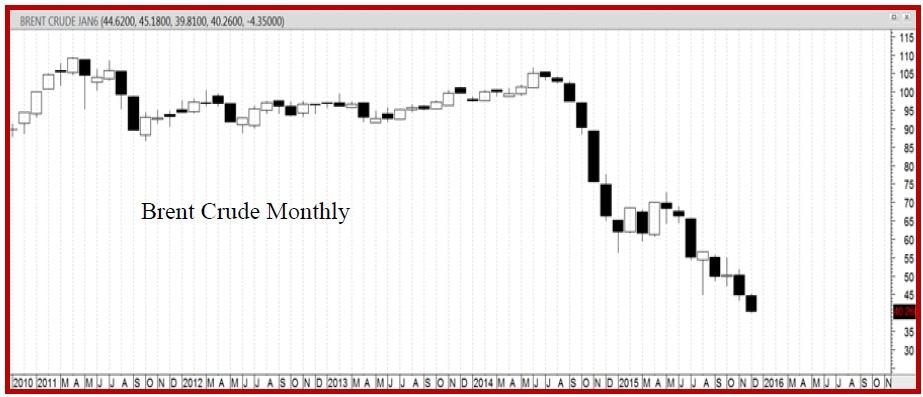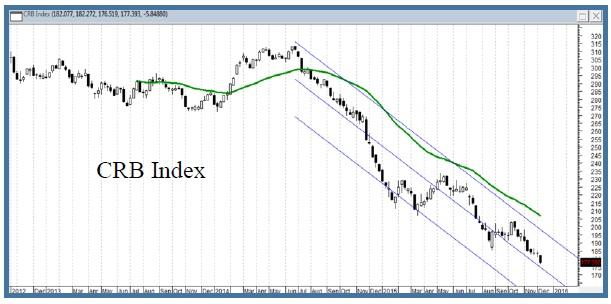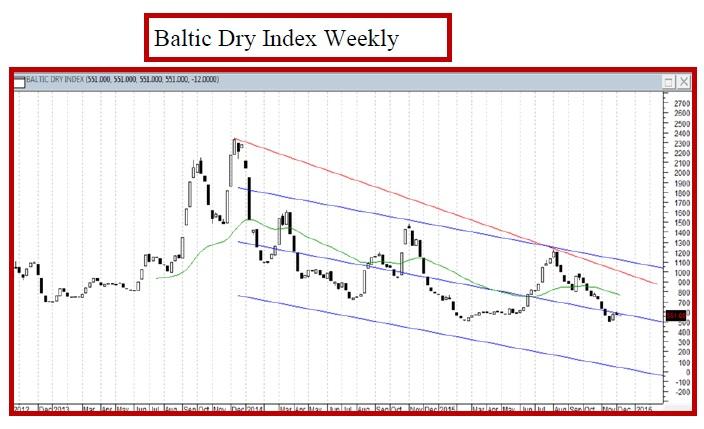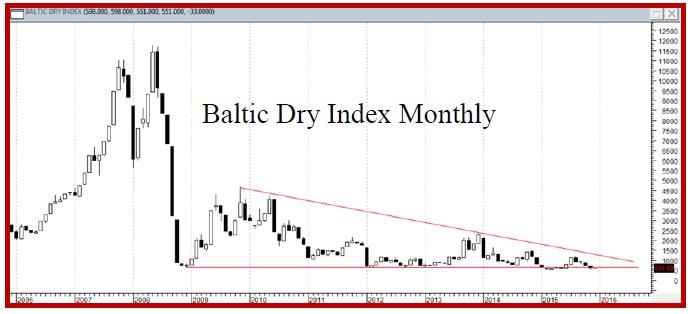Outlook:
We don’t get any juicy news in the US today, leaving plenty of time to ponder Donald Trump vs. the Constitution. See the Tidbit below. Tomorrow the news includes retail sales, possibly a bummer given the 10% drop in Thanksgiving shopping. We also have central bank meetings in New Zealand, Switzerland and the UK. Maybe that will sharpen appetite for next week’s FOMC.
We can also spend some time on oil. We have heard moaning and wailing about the price of oil and oth-er commodities for a very long time, but when you look at the chart of Brent on the monthly basis, it really knocks your socks off. See below. The markets are not adapting gracefully to falling prices. The FTSE 100 is particularly energy-heavy (and down 0.13% around 1 pm local time).
The New York Times reports that the billions of dollar invested by energy companies in the past 15 years to satisfy never-ending demand from China is weighing heavily now that the China slowdown is going global. “At least seven American coal companies have declared bankruptcy this year. The Swiss company Glencore is scrambling to reduce its $30 billion debt by a third before the end of 2016 by slashing its copper-mining operations in Zambia and the Democratic Republic of Congo and selling much of it agricultural business.
“Anglo American, the world’s fifth largest mining company, announced it would unload 60 percent of its mines and smelters. It is reducing its 135,000-man work force to 50,000, as it cuts its business units to three from six. ‘While we have continued to deliver our business restructuring and performance ob-jectives across the board, the severity of commodity price deterioration requires bolder action,’ Mark Cutifani, the company’s chief executive, said in a statement. The company characterized the changes as a more ‘radical restructuring’ than it had previously announced.”
Key phrases—“severity of the commodity price deterioration” and “radical restructuring.”
We can already see the effect in the Baltic Dry Index, a broad measure of trend in global business activi-ty. It is wildly imperfect and can be criticized from several directions, but take a look anyway. The weekly chart shows a flop in activity from a peak in November last year. Three surges of recovery failed and ended in lower lows. The index is tracking linear regression and that in turn is being tracked by the 200-day/40-week green line.
But before freaking out that the world is grinding to a halt, consider the monthly chart, which has the virtue of going farther back to the peak and then crash in 2008. If we are getting another crash, it’s on a far lower scale. In fact, it’s a little interesting that the index is not falling much below the lowest low from Dec 2008 at 663.00. The index breaks the line but not by much and not for long. This doesn’t necessarily mean anything. Nothing says activity can’t slow by another 50%. But so far, the commodity price crash and resulting slowdown in shipping is nowhere near as bad as the crisis of 2008.
Let’s pretend that the oil/commodity price deterioration continues. Bumps up are not a recovery, just bumps up. Where does this leave the dollar? Remember, the relatively new conventional wisdom has it that oil and the dollar are inversely correlated. It’s not true and not even logical, but never mind. It’s baked into traders’ heads. This week we have oil hitting new multi-year lows but the dollar not respond-ing as it’s supposed to by rising. Where is the oil/dollar connection and are we seeing the formation of a new connection?
Not to beat a dead horse, but it’s obvious that a continuation of falling energy and commodity prices is deflationary at a time when major country central banks are seeking to get some inflation. In a way, the falling prices undermine the divergent-policy thesis—the US will be a lot less hawkish because it fears the absence of inflation cuts into its credibility. This is probably not a baseless fear. The flattening of the yield curve is not helping and heaven forbid it goes inverted. An inverted yield curve always brings out the gang who say an inverted yield curve means recession, Samuelson’s joke notwithstanding (“an in-verted yield curve has predicted nine of the last five recessions”).
This kind of thinking causes big players to pare back long dollar positions and not just as temporary tac-tic until the divergent-policy thesis returns to the fore. In other words, it could be a turning-point signal and not just incidental and coincidental noise.
The more likely view is that a breakout like the euro’s jump to 1.0981 last Thursday on the Draghi Dis-appointment has to play out on the chart—a test of the high that fails. Then the downmove can resume, if in fits and starts, The sage Market News FX reporter has a fabulous single sentence: “Long-term euro bears were wary of going short again and preferred to wait for more attractive levels, i.e. closer to $1.1000, to do so.” Long-time market observers expect the urge to sell to re-emerge if and when a test of the old high fails, something that could or should happen today or at least by the end of the week. If the euro surpasses 1.1050, this bet would be off.
Political Tidbit: Presidential candidate Trump’s proposal to ban all Muslims from entering US came under attack from all sides. Even the UK and French prime ministers spoke out, something that has never happened before (sitting PM commenting on a US candidate). Not a single member of 535 in Congress backs Trump and that’s a rich pool of nitwits. The Pentagon says Trump is a danger to US se-curity because his rhetoric promotes the ISIL narrative. The White House says the Trump proposals, which violate at least two Constitutional rules (First and Fifth Amendments), disqualifies him from be-coming president. And as noted before, Trump’s supporters are a tiny number—only 30% at most of the 28% of people identifying as Republican in polls, or 8.4%.
Oddly, a Temple University law professor has an op-ed in the NYT saying the Supreme Court may well find Muslim exclusion to be constitutional, based on the “plenary power” doctrine dating back to the 1889 decision in the Chinese Exclusion case allowing the exclusion of Chinese laborers based on nation-ality. Even the internment of Japanese-Americans was not actually overturned by the Court. “Nor has the Supreme Court ever struck down an immigration classification, even ones based on race. As late as 1965, a federal appeals court upheld a measure that counted a Brazilian citizen of Japanese descent as Asian for the purposes of immigration quotas… In the context of noncitizens seeking initial entry into the United States, due process protections don’t apply, either. This past June, the court upheld the denial of a visa for the spouse of an American citizen based on the government’s say-so, with no supporting evidence.” Oh, dear.
All the same, the vast majority of people, official and otherwise, think the Trump proposals are unconsti-tutional. The important point is that Trump thinks so, too. It’s not really likely that he forgot the 6th grade lessons on the Constitution. Political commentator Maddow has a theory—Trump is a fairly smart guy. Going overboard is a deliberate ploy to lose the nomination and then he can blame political correct-ness. Trump doesn’t actually want the job, which is hard, but the self-styled winner needs a good excuse for losing.
While it’s somewhat gratifying that the rest of the world is paying such close attention to the US presi-dential race, it’s also embarrassing. Consolation comes in the form of remembering the bell-shaped standard distribution. Every country has two tail of fruitcakes on either side of the norm. The UK is not a little embarrassed at the new Labour guy, Corbyn. France has LePen.
Is this the end of Trump? Yes, probably. It has yet to play out and we could get a third-party run or any number of alternative endings, but Trump as the ultimate nominee is almost certainly a non-starter.
| Current | Signal | Signal | Signal | |||
| Currency | Spot | Position | Strength | Date | Rate | Gain/Loss |
| USD/JPY | 122.63 | LONG USD | STRONG | 10/23/15 | 120.45 | 1.81% |
| GBP/USD | 1.5066 | SHORT GBP | WEAK | 11/06/15 | 1.5137 | 0.47% |
| EUR/USD | 1.0933 | SHORT EURO | NEW*WEAK | 12/08/15 | 1.0858 | -0.69% |
| EUR/JPY | 134.08 | LONG EURO | NEW*STRONG | 12/04/15 | 133.59 | 0.37% |
| EUR/GBP | 0.7257 | SHORT EURO | WEAK | 10/23/15 | 0.7194 | -0.88% |
| USD/CHF | 0.9905 | LONG USD | NEW*WEAK | 12/08/15 | 0.9973 | -0.68% |
| USD/CAD | 1.3565 | LONG USD | STRONG | 10/28/15 | 1.3235 | 2.49% |
| NZD/USD | 0.6612 | LONG NZD | NEW*STRONG | 12/04/15 | 0.6641 | -0.44% |
| AUD/USD | 0.7195 | LONG AUD | WEAK | 11/23/15 | 0.7174 | 0.29% |
| AUD/JPY | 88.23 | LONG AUD | WEAK | 10/08/15 | 86.06 | 2.52% |
| USD/MXN | 16.9690 | LONG USD | NEW*WEAK | 12/07/15 | 16.7258 | 1.45% |
This morning FX briefing is an information service, not a trading system. All trade recommendations are included in the afternoon report.
Recommended Content
Editors’ Picks
AUD/USD remains under pressure from RBA rate decision

AUD/USD spiked lower by more than 20 pips following the RBA rate announcement to test the key psychological support at 0.6600. Losing this key level could see the currency pair trek lower towards the 100-hour EMA support near 0.6580.
USD/JPY extends recovery above 154.00, focus on Fedspeak

The USD/JPY pair trades on a stronger note around 154.10 on Tuesday during the Asian trading hours. The recovery of the pair is supported by the modest rebound of US Dollar to 105.10 after bouncing off three-week lows.
Gold price extends its upside as markets react to downbeat jobs data

Gold price extends its recovery on Tuesday. The uptick of the yellow metal is bolstered by the weaker US dollar after recent US Nonfarm Payrolls (NFP) data boosted bets that the Federal Reserve would cut interest rates later this year.
Bitcoin miner Marathon Digital stock gains ground after listing by S&P Global

Following Bitcoin miner Marathon Digital's inclusion as an upcoming member of the S&P SmallCap 600, the company's stock received an 18% boost, accompanied by an $800 million rise in market cap.
The impact of economic indicators and global dynamics on the US Dollar

Recent labor market data suggest a cooling economy. The disappointing job creation and rising unemployment hint at a slackening demand for labor, which, coupled with subdued wage growth, could signal a slower economic trajectory.



